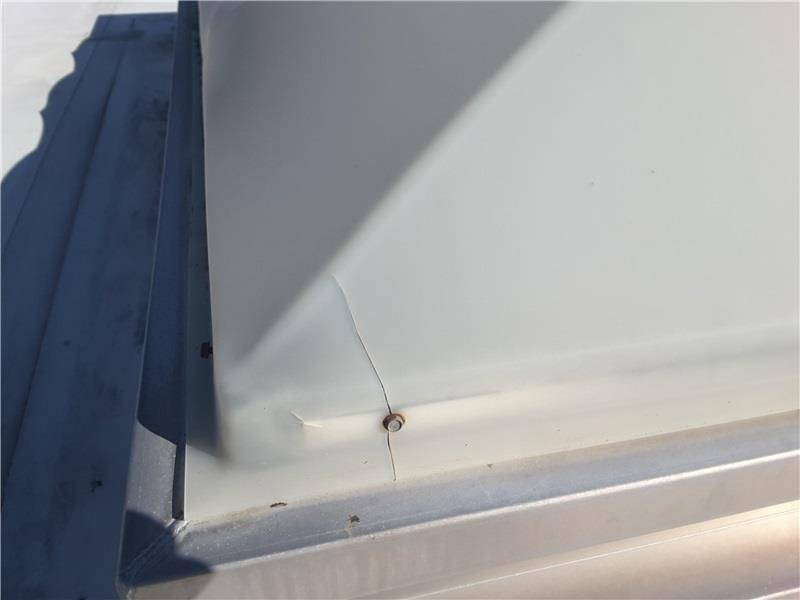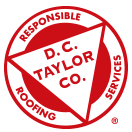Top 5 Commercial Skylight Concerns
Wide open expanses of rooftop space are often dotted with prismatic skylights. The energy savings they can achieve by supplementing artificial light with sunlight make them a popular rooftop feature. If you don’t address potential problems though, there’s a real downside to the reduced power costs.
No. 1 Skylight Leaks
Water infiltration is often the first sign of a problem with commercial skylights. “Where the bubble meets the frame, there’s a rubber seal,” explains Dan Edie, Service Field Office Manager, D. C. Taylor Co., Concord, CA. “Sometimes that wears out or is impacted by heat. It might create an opening for water to get inside.” Compromised seals aren’t the only way water enters; damaged frames and cracks are also to blame.

No. 2 Impeding Roof Drainage
Usually, the placement of skylights on the roof takes into consideration the drainage path of water. When it doesn’t, rainwater may collect behind the skylight. “Ponding water and sunlight will cause premature deterioration of the membrane and create a leak,” explains Edie. The solution is crickets to divert the water around a skylight.
No. 3 Inoperable Smoke Vent/Hatch
“Large warehouses often have smoke hatches. They pop open to vent if there’s a lot of heat,” says Edie, who recognizes the danger when functionality is impaired. A broken release handle, a rusty wire, hatches don’t close entirely – he’s seen it all.
No. 4 Security
For all the benefits of skylights, they can also create a security concern, providing access into the building for vandals and thieves. A rack of bars – sometimes referred to as burglar bars – will prevent entry. “They can be installed underneath the curb,” explains Edie, “or above the curb and the skylight goes on top.”

No. 5 Safety Hazards
Serious injury and even death are possible when a rooftop worker falls through a skylight. The U.S. Department of Labor’s Occupational Safety and Health Administration (OSHA) requires that employers protect workers from these dangers. OSHA classifies skylights as holes, the administration’s website states. “As soon as anyone sets foot on the roof, the hazard is present and must be protected,” adds Kirk Dighton, Safety Manager, D. C. Taylor Co., Cedar Rapids, IA.
There are several options for protecting individuals working around skylights. Be suspicious about marketing claims that seem too good to be true, warns Dighton: “OSHA-approved isn’t a thing. It needs to be compliant with a particular standard,” he says. The cover or protection must, according to 1926.502(i)(2), “… be capable of supporting, without failure, at least twice the weight of employees, equipment, and materials that may be imposed on the cover at any one time.”
The burglar bars mentioned earlier are not included as fall protection options in the federal OSHA regulations; however, California’s OSHA has approved these as skylight screens installed below the skylight, as long as they meet the following criteria:
- The grillwork has openings less than 12 inches in the least horizontal dimension.
- They shall be designed by a qualified person.
- They must be capable of safely supporting the greater of 400 pounds or twice the weight of the employees, equipment, and materials that may be imposed on any one square foot area of the cover at any time.
- They cannot be installed more than 2 feet below the walking/working surface.
If the skylight glazing imposes an impalement hazard, burglar bars cannot be considered fall protection.
Guardrail is an acceptable fall protection strategy for skylights. There are a few disadvantages, though. It’s more expensive than other alternatives, especially if you have a large number of skylights on the roof. And on a crowded roof, guardrail may not make sense. Lastly, workers must be tied off when working inside the guardrail.
Consider skylight screens (aka cages). These attach over the top of the skylight without impeding sunlight. California OSHA requirements dictate the following: “The construction shall be of grillwork, with openings not more than 4 inches by 4 inches or of slatwork with openings not more than 2 inches wide with length unrestricted, or of other material of equal strength and similar configuration.” (While the appearance of these cages may deter criminals, they are not a replacement for burglar bars as they can be unscrewed to allow access into the building.)

Temporary nets include a framed system around woven cord mesh. “D. C. Taylor Co. uses them quite a bit. It looks like a big soccer net that you put down over the top of a skylight. It would catch anyone that accidentally falls into it,” says Dighton. If you have employees or trades working on the roof regularly, it’s important to consider a more permanent option. It’s unrealistic to assume that workers will place these nets over skylights each time they perform rooftop work. They are not meant to be left on skylights permanently; however, as a temporary measure, they are effective.
Schedule Regular Roof Inspections
Routine roof inspections typically catch skylight problems. “If the skylight is leaking, they’ll put caulking around it. That’s a sign they’ve got problems,” notes Edie.

All of defects noted above are signs that repair, retrofit, or replacement is necessary. A simple Google search on the average life of a skylight will provide results ranging from 5-30 years. Edie says realistically to expect between 10 and 15 years. Not surprisingly, the quality of skylight materials and construction also impacts its durability and consequently, life expectancy. Edie advises customers not to compromise quality for cost when it comes to skylights and recommends aluminum-framed polycarbonate options.
Your roofing contractor will likely suggest security and safety for your skylights if they don’t see either present already. They’ll help you evaluate which options make the most sense for your roof.
A routine roof inspection can identify a tricky leak or potentially save a life. Don’t neglect; inspect!
To schedule your roof inspection, contact D. C. Taylor Co. at 319.731.4118.






 Previous
Previous